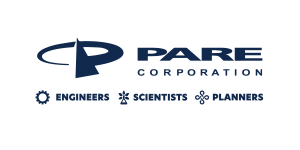Problems with Concrete Materials
Contents
- Construction Errors
- Disintegration and Scaling
- Cracks
- Efflorescence
- Erosion
- Spalling and Popouts
- Inspection and Monitoring
- Dam Owner Academy
- Save this page as a printable Dam Owner's Fact Sheet [PDF]
Visual inspection of concrete will allow for the detection of distressed or deteriorated areas. Problems with concrete include construction errors, disintegration, scaling, cracking, efflorescence, erosion, spalling, and popouts.
Construction Errors
Errors made during construction can include adding improper amounts of water to the concrete mix, inadequate consolidation, and improper curing can cause distress and deterioration of the concrete. Proper mix design, placement, and curing of the concrete, as well as an experienced contractor are essential to prevent construction errors from occurring. Construction errors can lead to some of the problems discussed later in this fact sheet such as scaling and cracking. Honeycombing and bugholes can be observed after construction.
Honeycombing can be recognized by exposed coarse aggregate on the surface without any mortar covering or surrounding the aggregate particles. The honeycombing may extend deep into the concrete. Honeycombing can be caused by a poorly graded concrete mix, by too large of a coarse aggregate, or by insufficient vibration at the time of placement. Honeycombing will result in further deterioration of the concrete due to freeze-thaw cycles because moisture can easily work its way into the honeycombed areas. Severe honeycombing should be repaired to prevent further deterioration of the concrete surface.
Bugholes is a term used to describe small holes (less than about 0.25 inch in diameter) that are noticeable on the surface of the concrete. Bugholes are generally caused by too much sand in the mix, a mix that is too lean or excessive amplitude of vibration during placement. Bugholes may cause durability problems with the concrete and should be monitored.
Disintegration and Scaling
Disintegration can be described as the deterioration of the concrete into small fragments and individual aggregates. Scaling is a milder form of disintegration where the surface mortar flakes off. Large areas of crumbling (rotten) concrete, areas of deterioration which are more than about 3 to 4 inches deep (depending on the wall/slab thickness), and exposed rebar indicate serious concrete deterioration. If not repaired, this type of concrete deterioration may lead to structural instability of the concrete structure. A registered professional engineer must prepare plans and specifications for repair of serious concrete deterioration. For additional information, see the “Concrete Repair Techniques” fact sheet.
Disintegration can be a result of many causes such as freezing and thawing, chemical attack, and poor construction practices. All exposed concrete is subject to freeze-thaw cycles, but the concrete’s resistance to weathering is generally determined by the concrete mix and the age of the concrete. Concrete with the proper amounts of air, water, and cement, and a properly sized aggregate, will be much more durable. In addition, proper drainage is essential in preventing freeze-thaw damage. When critically saturated concrete (when 90% of the pore space in the concrete is filled with water) is exposed to freezing temperatures, the water in the pore spaces within the concrete freezes and expands, damaging the concrete. Repeated cycles of freezing and thawing will result in surface scaling and can lead to disintegration of the concrete. Hydraulic structures are especially susceptible to freeze-thaw damage since they are more likely to be critically saturated. Older structures are also more susceptible to freeze-thaw damage since the concrete was not air entrained. In addition, acidic substances in the surrounding soil and water can cause disintegration of the concrete surface due to a reaction between the acid and the hydrated cement.
Cracks
Cracks in the concrete may be structural or surface cracks. Surface cracks are generally less than a few millimeters wide and deep. These are often called hairline cracks and may consist of single, thin cracks, or cracks in a craze/map-like pattern. A small number of surface or shrinkage cracks is common and does not usually cause any problems. Surface cracks can be caused by freeze-thaw cycles, poor construction practices, and alkali-aggregate reactivity. Alkali-aggregate reactivity occurs when the aggregate reacts with the cement causing crazing or map cracks. The placement of new concrete over old may also cause surface cracks to develop. This occurs because the new concrete will shrink as it cures. Surface cracks in the spillway should be monitored and will need to be repaired if they deteriorate further. Structural cracks in the concrete are usually larger than 0.25 inch in width. They extend deeper into the concrete and may extend all the way through a wall, slab, or other structural member. Structural cracks are often caused by settlement of the fill material supporting the concrete structure, or by loss of the fill support due to erosion. The structural cracks may worsen in severity due to the forces of weathering. A registered professional engineer knowledgeable about dam safety should investigate the cause of structural cracks and prepare plans and specifications for repair of any structural cracks.
Efflorescence
A white, crystallized substance, known as efflorescence, may sometimes be noted on concrete surfaces, especially spillway sidewalls. It is usually noted near hairline or thin cracks. Efflorescence is formed by water seeping through the pores or thin cracks in the concrete. When the water evaporates, it leaves behind some minerals that have been leached from the soil, fill, or concrete. Efflorescence is typically not a structural problem. Efflorescence should be monitored because it can indicate the amount of seepage finding its way through thin cracks in the concrete and can signal areas where problems (i.e. inadequate drainage behind the wall or deterioration of concrete) could develop. Also, water seeping through thin cracks in the wall will make the concrete more susceptible to deterioration due to freezing and thawing of the water.
Erosion
Erosion due to abrasion results in a worn concrete surface. It is caused by the rubbing and grinding of aggregate or other debris on the concrete surface of a spillway channel or stilling basin. Minor erosion is not a problem but severe erosion can jeopardize the structural integrity of the concrete. A registered professional engineer should prepare plans and specifications for repair of this type of erosion if it is severe.
Erosion due to cavitation results in a rough, pitted concrete surface. Cavitation is a process in which subatmospheric pressures, turbulent flow and impact energy are created and will damage the concrete. If the shape of the upper curve on the ogee spillway is not designed close to its ideal shape, cavitation may occur just below the upper curve, causing erosion. A professional engineer should prepare plans and specifications for repair of this type of erosion if the concrete becomes severely pitted which could lead to structural damage or failure.
Spalling and Popouts
Spalling is the loss of larger pieces or flakes of concrete. It is typically caused by sudden impact of something dropped on the concrete or stress in the concrete that exceeded the design. Spalling may occur on a smaller scale, creating popouts. Popouts are formed as the water in saturated coarse aggregate particles near the surface freezes, expands, and pushes off the top of the aggregate and surrounding mortar to create a shallow conical depression. Popouts are typically not a structural problem. However, if a spall is large and causes structural damage, a registered professional engineer should prepare plans and specifications to repair the spalling.
Inspection and Monitoring
Regular inspection and monitoring is essential to detect problems with concrete materials. Concrete structures should be inspected a minimum of once per year and after any significant weather event. The inspector should also look at the interior condition of concrete spillway conduit. Proper ventilation and confined space precautions must be considered when entering a conduit. It is important to keep written records of the dimensions and extent of scaling, disintegration, efflorescence, honeycombing, erosion, spalling, popouts, and the length and width of cracks. Structural cracks should be monitored more frequently and repaired if they are a threat to the stability of the structure or dam. Photographs provide invaluable records of changing conditions.
A rapidly changing condition may indicate a very serious problem, and the State Dam Safety Agency should be contacted immediately. All records should be kept in the operation, maintenance, and inspection manual for the dam.
Dam Owner Academy
The Dam Owner Academy is a series of videos to educate and inform owners on all aspects of operating and maintaining a dam safely. The videos concisely present the critical basics of owner responsibilities and are available as a free resource for owners and those conducting owner outreach programs.
The "Concrete Problems & Repairs" video covers problems with concrete materials.


































